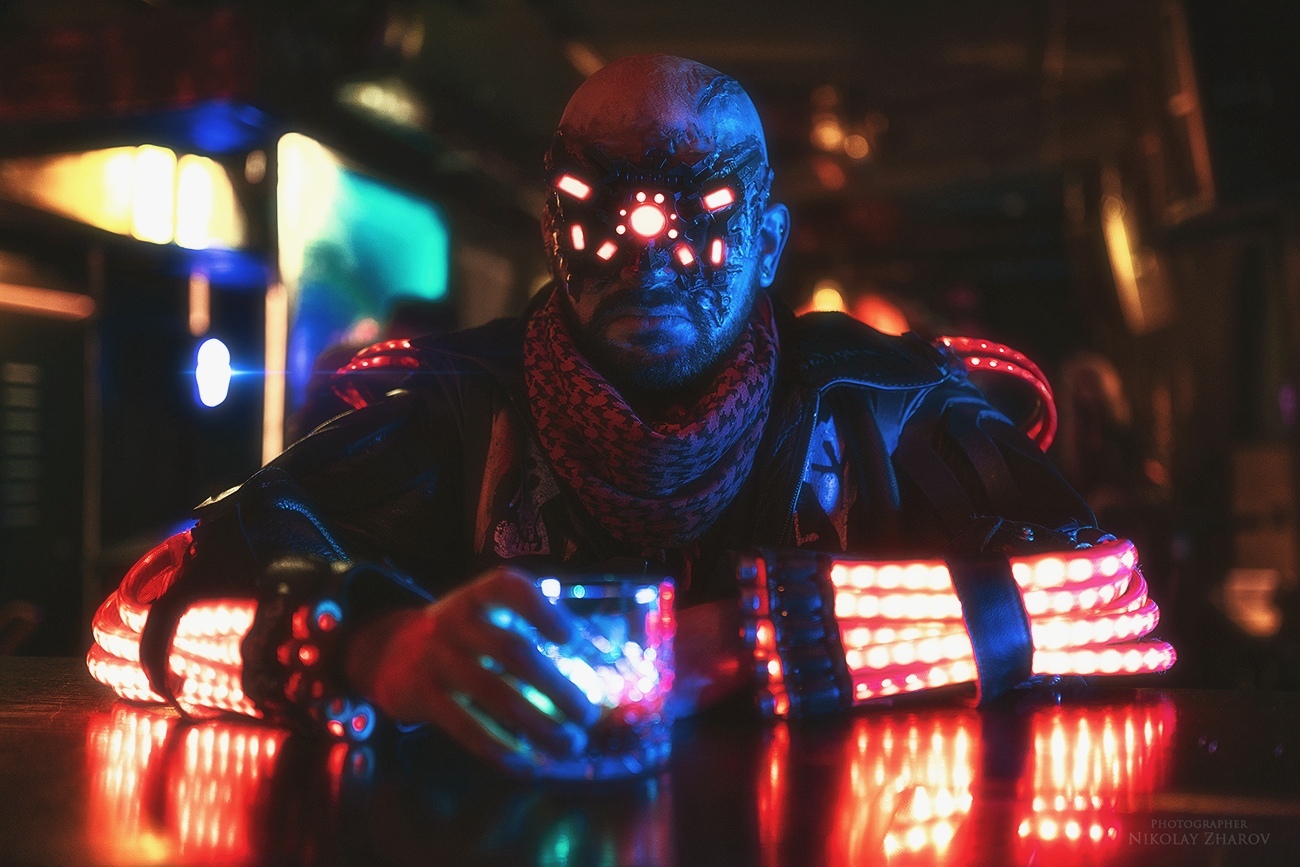
The most famous image of Elizabeth from Bioshock in the real world, photo courtesy of Anna Moleva
Hello! I will continue to introduce you to the strange geeks. If you've ever disguised yourself as Santa Claus, wore a subnet mask on Halloween, or attended some costume party, then you are a kind of cosplayer too. Once upon a time I also started as a forest elf, only I had a curtain cloak and a ski sword (reinforced with green duct tape, which distinguished us from the orcs): still, field action and cosplay have different priorities. We, the wood elves, tried to stagger rather than impress with our appearance. And the last "adult" trip was generally along the Stalker, because there the suit consisted of camouflage, ankle boots, a respirator and dirt. Now half the city is cosplaying it.
But behind this story of disguise for specific characters is a whole huge social phenomenon, largely due to the video game industry. Let's tell you what is happening in this gloomy world of postmodernism. With us today, the beautiful Anna Moleva, better known as Ormeli, is the same girl who became the official Elizabeth from Bioshock, won the II place in the Cyberpunk 2077 cosplay with Lizzie-Wizzie and made 20 more different famous images. So it is quite possible that some people know her as three or four different people.
The life of a cosplayer is a perfect snapshot of how the Web works. Because there is a crazy business model based on the fan community, and the pursuit of (real) maniacs from Dvach, and the passage through the airport security in the image of Sylvanas from WoW with the corresponding mass-dimensional weapon model. There was cosplay before the development of the gaming industry, but it was games that made it incredibly popular.
Let's start with the part where it turns out that the cosplayer earns almost nothing on average, but maybe a lot.

Financial analyst and system administrator near the site of the "Hinode" festival
How can you earn
1. Model contracts are when the image is so awesome that you are chosen as the physical embodiment of a fictional character. Actually, this happened between the studio with the rights to Bioshock and Ormeli, and made her the official "incarnation" of Elizabeth in the real world. This is currently the best recognition of a cosplayer in the world. But only a few people do it. Well, this is not the purpose of cosplay itself: after all, it is a hobby, not an attempt to make money.
2. Selling content or donations.The cosplayer gathers around himself a community of fans who like the looks, the level of preparation of the costumes, or something else. Either appearance. The second spawned a huge market for a very strange erotic cosplay on Patreon and Onlyfans, where girls of exciting appearance offer to see how naked characters from different games and films look. Rule 34 has not been canceled. From the point of view of a business model, this is quite an interesting building of a personal brand and its subsequent monetization. The problem is that the main asset is, in fact, gradually amortized over 7-8 years, that is, the business needs to be diversified. But if you look at Patreon's reports, you will see this:

In the conventional cosplay category, roughly 100 people have over 100 followers, and roughly 200 people make over $ 500 per month. And here is the category of adult cosplay: The

guidelines for monthly income are:

That is, there may be 4-5 times more money, but the orders of popularity (and the chances of making it the main income) are about the same.
Anna's word:
« . . , . , , . , , , Onlyfans. - - , , , . . – Instagram, , Facebook. - TikTok. , , , . . Deviantart , , . , , Instagram, , , ».
3. Merch selling is when a cosplayer makes their own souvenirs. It goes well (especially in Japan), but there is an acute issue with licenses, because usually all modern game characters are firmly owned by someone, and this someone himself earns on merch.
4. Participation in festivals (for example, in the jury). Ormeli, as an expert in this matter, says that there is almost no money there, but there are many shareware trips around the world.
5. Crafting- since the cosplayer makes costumes and accessories in one way or another, they can be sold. Suits can cost 200-300 thousand rubles quite calmly at a cost of 50-60 thousand. In Russia, it is much more common to sell some kind of things like robotic arms made of plastic or craft for Fallout for large field games. Plus, when there was a boom in exit-room quests, all crafting workshops were loaded with orders for entourage for them. Ormeli is engaged in metal work with a business partner. It was this crafting skill that helped make Lizzie's iron suit, by the way.
6. Other monetization of the community (Kickstarter, channels, streams, etc.).
That is, the main asset of the cosplayer is the community. Here, a cosplayer according to a financial model is not very different from the same Green Cat in fact. Only he could earn by speaking at conferences (when they were) 300-500 thousand rubles a month, but he could hardly sell merchandise (we once discussed this in Mosigra).
There are two approaches to a community-based business: either building a community around a product (Mosigra is a great example), or building a community and finding a product for it. For example, the story of Flipper Zero zhovner- probably the best example in recent years of how at first it took a long time to create a community, and then a product was found for it with a launch on Kickstarter.
Since the cosplayer is remembered by images, there is still a separate conflict: it is not a fact that they all will form a single person.
“A lot of people know me from my different cosplays, but they don't even have an idea that they are all the same cosplayer. Very often people come to me, they begin to list my costumes, "I thought they were 3 different girls, like that." This is my most frequent problem. Not to mention the fact that I am basically not recognized without a suit. Although no, probably now many people will recognize me without a suit, but not always in new images. "
“My principal credo as a cosplayer is that I have a rule that the cosplayer should not be seen behind the cosplay. That is, I do not want to be said about me that “oh, this is the same Anna Moleva, just in someone's costume”. I want people, when they see my photos or some of my video works, or me live, they see the character in front of them in life. "
But if fans often do not define the cosplayer as a person (we are not talking about the core of the audience, namely the broad strata), that is, the positive side of fame comes much later, then Ormely received the negative side in full:
« - … , , , , - . , - - . , . - , , , , . . . , , , . , , , . , , , . … , , , , - . , , , , - . , , . , . , , , -, , . , . , , , . . , , - ».
Why then do people do it?
Because it's a hobby.
If we turn to the history of games, then one of the oldest and most interesting games is the subtypes of theater, in the basic mechanics - the game of dressing up. We really like to impersonate someone else, and it seems to touch on some deep things.
At the very least, you can be a little not yourself and try other models of behavior, and then write off everything to the character. That is, you can do all day what was not allowed in the image of yourself. Perhaps this is the essence of the game.
With the development of the web, this can still collect likes, and this is an art form too.
What separates a good cosplayer from a bad one?
The presence of a fan base, that is, the size of the community and possible contacts. Only this is a metric from the category of KPI: it is absolutely useless tactically, but it allows you to measure the result retroactively. Actually, why is this important - because cosplayers give game publishers access to the audience bypassing advertising filters (after all, this is beautiful, this is creativity) and allow new images to be brought in on time. Which is very, very valuable for them as an advertisement.
But the ability to dial contacts is already directly dependent on skills. I would highlight the following things:
- . , , , , , — , , . — , , , -.
- . — , , . ( , ) - . .
- . , , , , , .
- : , , .
« , … , . , , . , , . . . . , . , , . - , - , - . . , , . , , . - . . ».

Role-playing have a lot of stories about “Don't hit me, Duncan Macleod”, and I myself got into such stories. It is especially interesting when such characters get home by taxi or commuter trains.
Ground support: suit preparation, travel
There are a lot of cosplayers and often travel to festivals and conventions. Well, okay, at least traveled before the pandemic. And this is where the interesting begins.
First, the costumes are rather big now. Two huge suitcases on top of the luggage are always welcome.
Secondly, somewhere there is a sword, knife, machine gun or other element of the costume. Let me remind you categories 5 and 6 from the law on weapons:
5) cold bladed weapons designed to be worn with a Cossack uniform, as well as with national costumes of the peoples of the Russian Federation, the attributes of which are determined by the Government of the Russian Federation;
6) weapons used for cultural and educational purposes:
weapons of cultural value;
old (antique) weapons;
copies of old (antique) weapons;
replicas of old (antique) weapons;
decommissioned weapons.
Since the cosplayer is not a Cossack or a reenactor, he does not have a certificate, and all this has to be taken out and shown, which causes a lot of interesting situations at airports.
« BlizzCon. , , , , . , , … , , , , , «, ». «, ». « , ». , , «, ». -, , , . , . , , « ?». , , , , , . , , . , , … … WOW, . , , , , « . , .» . , , , , ».
Thirdly, you often need to go in a costume to the festival around the city, so as not to try to change there in the toilet. That is, a ball gown with a crinoline in a taxi is also not a question.
And fourthly, since cosplayers are keenly interested in creating content, they do not just travel to another city, but also actively use all interesting and iconic places for photo shoots there. This means that you need to take another 1-2 suits there.
Of course, festivals make serious concessions for special guests: here the airport is often aware of what kind of event will be; and there are large dressing rooms; and all consumables like napkins, spare shoes (yes) and other necessary things are quite common.

This is not Royce, this is the coolest Alexander Kuzmenkov. Photographer Nikolay Zharov. A source...
Cosplay is an activity where being in character is a goal in itself. Carnival participants cannot be considered cosplayers in the traditional sense, because they do not have the goal of "embodying" a character from a book, movie or game, but they just want bread, trash, frenzy and spectacles. Participants in field role-playing games too: despite the very deep elaboration of costumes and makeup, the goal is still to play the game, and not just show the character. So classic cosplay is a reconstruction of an image, its embodiment and broadcast to the maximum number of people. That is, in fact, it is absolutely the same model as that of any art activity. So if you are now professionally versed in cosplay, then you are roughly similar to the connoisseur of painting from the Royal Gallery of Art of the nineteenth century. Only you don't know yet that this is snobbery.
The beautiful Anna Moleva (Ormeli) was with us today. Here is an interview with her live with a bunch of other details, if interested - and a story about Cyberpunk Lizzie.